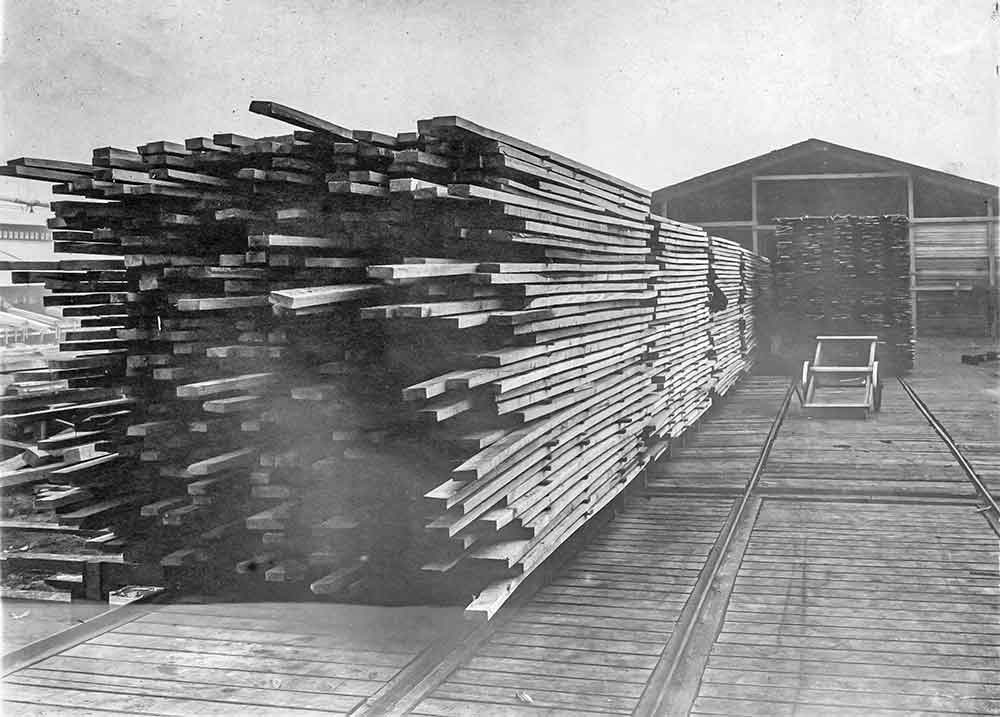Diboll Withstands The Test Of Names
Article by Rich Donnell, Editor-in-Chief, Timber Processing July 2022
Do you want to get confused? Let’s go to Diboll, Texas. Here you’ll find the Georgia-Pacific sawmill, which is our cover story this issue as written by Senior Editor Jessica Johnson.
That GP owns this sawmill, and has recently completed some upgrading to it, is the easy part. The difficult part is tracing back the history of the sawmill, and more specifically the number of ownership names that come into play, even if those names were mostly from the same company. See what I mean?
The first sawmill to be built at Diboll (a good one anyway), in 1894, was at the hands of Southern Pine Lumber Co., which was founded by Thomas Temple, Sr., who had purchased 7,000 acres of east Texas forest the year before from the man who founded Diboll, J.C. Diboll. Southern Pine Lumber continued to expand the mill and in 1903 built a second one.

Diboll sawmill, 1903 (as downloaded from The History Center Online)
In 1910, Temple formed Temple Lumber Co. by purchasing Garrison-Norton Lumber and its operations and later added operations in Pineland.
In 1956, Temple Lumber and Southern Pine Lumber merged under the Southern Pine Lumber name. But wait, in 1963 Southern Pine Lumber Co. changed its name to Temple Industries, Inc., and in addition to wood products operations now owned more than 450,000 acres. In 1969, it rebuilt the Diboll sawmill after a fire.
In 1973, Time Inc. (yep, that Time Inc.) acquired Temple Industries and merged it with Eastex Pulp and Paper Co., resulting in the name Temple-Eastex, Inc. Of course by now the company had multiple sawmill and panel operations, and in 1979 Temple-Eastex moved into new corporate offices at Diboll.
In 1983, Time Inc. spun off its forest products operations, and stockholders formed a new company, Temple-Inland Inc., which was composed of the old Temple-Eastex Corp. and Inland Container Corp.
In 1985, our magazine visited and wrote an article on the Diboll mill, which operated as Temple-Eastex (or at least that’s what we called it), but a few years later the Temple-Eastex portion of the business changed its name to Temple-Inland Forest Products. Our magazine visited Diboll again in 1999, following a $26 million total overhaul of the sawmill, and it was Temple-Inland then.
Temple-Inland operated the mill until 2012, when it sold it and other wood products operations to International Paper, which turned around in 2013 and sold Diboll and other operations to Georgia-Pacific.
In retrospect, it’s no wonder that us editors were always confused about which Temple to call the Diboll sawmill. But the amazing thing about all of this, really, is that a sawmill at the Diboll site is now in its 128th year of operation, as our article beginning on page 18 bears out.
Latest News
Lumber Among Three Big Input Reductions
Softwood lumber is one of the three largest construction input cost reductions year-over-year from December 2021 to December 2022, according to a recent ConstructionDive market report. Citing Producer Price Index data from December 2022, the report noted that overall…
Biofuels Project Sinks
The Red Rock Biofuels project in southern Oregon appears headed for foreclosure according to notices published in the Lake County Examiner newspaper in late December after the company failed to make principal and interest payments on some $300 million in debt. The notice set a February 4 payment…
Opticom Celebrates 50th Anniversary
Opticom Technologies, a leader in industrial video monitoring solutions, is celebrating 50 years in business. The company, founded in 1973, has evolved to continue offering innovative products as video monitoring technology has advanced. “It’s unique for a video monitoring company to have 50 years of history under its belt,” comments Opticom Global…
Structurlam Temporarily Suspends Arkansas Operations
Structurlam Mass Timber Corp., a mass timber manufacturer in North America, has announced it is temporarily suspending operations and reducing staff at its Conway, Ark., plant due to a customer contract cancellation…
Find Us On Social
Newsletter
The monthly Timber Processing Industry Newsletter reaches over 4,000 mill owners and supervisors.
Subscribe/Renew
Timber Processing is delivered 10 times per year to subscribers who represent sawmill ownership, management and supervisory personnel and corporate executives. Subscriptions are FREE to qualified individuals.
Advertise
Complete the online form so we can direct you to the appropriate Sales Representative.
